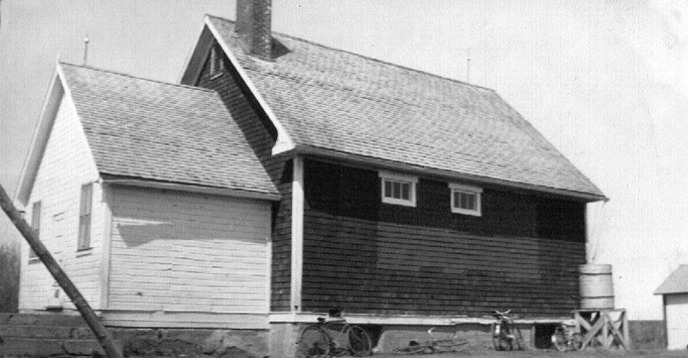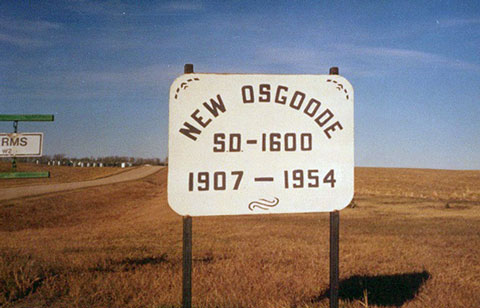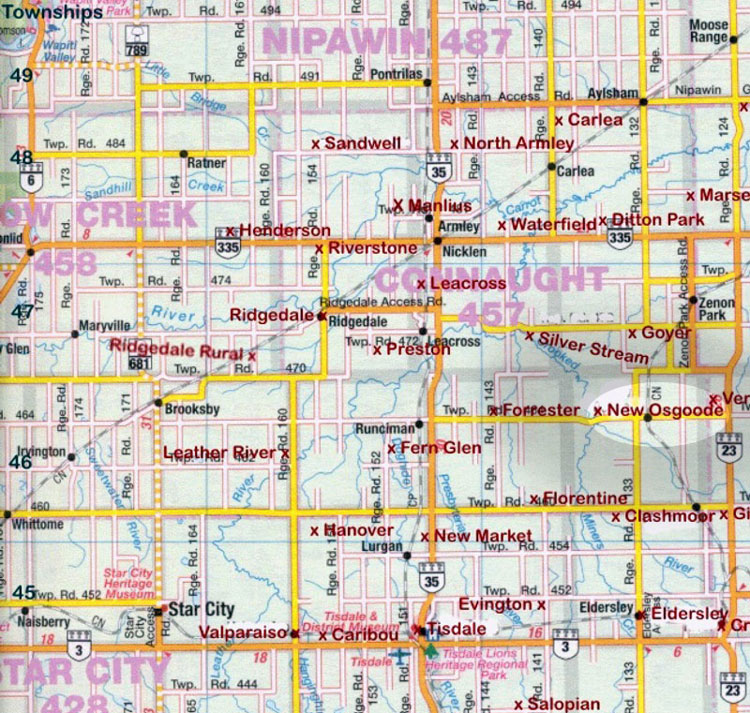New Osgoode School District # 1600

A meeting of the “resident ratepayers of the proposed New Osgoode School District” was held at the home of Mr. W.H. Howes on June 11, 1906. Mr. W.H. Howes was appointed chairman and Mr. F. E. Blowers, secretary. The New Osgoode School District No. 1600 was officially established on August 15, 1906.
Construction of a school building began in the summer of 1907 on the SW corner of the SE29-46-13- W2, under the direction of Fred and Alfred Howes. The inside dimensions of the school were to be 31 by 23 by 11 feet. The project was financed by a Debenture of $800.00.
Genevieve Beard was engaged as the first teacher and room off the parlour in the newly constructed two story log home of Alonzo Howes on the SW 28-46-13-W2 was used for classes until the school could be completed.The first class consisted of five students. Sometime in the fall, before the snow came, the students and teacher moved into the new school amid the noise of ongoing construction. They sat on benches until double desks with cast iron sides were installed. There was a large barrel wood stove at the back of the room with stove pipes that ran to the chimney at the front of the school. School was open only until Christmas of that first year.
About two years after the original school construction a barn was built. An ice-house was added about 1915 and underwent several modifications over the years. In the early 1920s the school was raised and a cement basement installed. A porch was added along with a huge circular shaped cement step. This step was the focus of controversy at the time - both for its extravagance and for the danger some felt it posed to students. (Apparently, not long after its construction, a student did fall and break a leg on the step.) A wooden slide, a backstop, two large swings, and two outdoor toilets completed the the school ground structures.
Over the 60 years it was open, New Osgoode School provided education for about one hundred fifteen families and more than four hundred individual students. Forty five teachers provided instruction at the school over the 60 years. One teacher Howard Atkinson, taught in the school for 13 years (1928-1941). Generally teacher turnover was high with four different teachers being recorded in 1951. For many years teachers boarded at homes in the district and walked to school. Apparently much friction and rivalry arose from time to time over who was to get the privilege - and income - from this undertaking. The practise of boarding ended when Mr. Atkinson purchased a house and moved it to a location near the school grounds. Later, he sold this to the school district. It was then moved to the north end of the school grounds, fixed up and rented to the teacher.
Various changes occurred through the years that affected the lives of both students and teachers. For many years girls wore skirts and dresses. These finally gave way to slacks and jeans - a welcome change for girls in winter. During one ten year period, inkwells and dip pens were replaced by fountain pens, which in turn were replaced by ball point pens. Softball replaced baseball, and girls were allowed to participate.
Travel to and from school also saw much variety and change through the years. At first, most of the students walked, often four or more miles each way. Eventually, more began to use horses for riding, or to pull carts, cutters, and toboggans. Commercial winter “bussing” facilities were provided by several local residents. These involved up to four horses and at times carried 20-25 students. Eventually, bikes and cars became common. All these eventually gave way to the school bus.
Other aspects of school life remained pretty much a ritual over the years; soccer in fall and winter, ball in spring, along with hopscotch, marbles, and rafts on the water-filled slough in one corner of the yard. A section of bush provided ample shelter for the occasional day of “hooky”; a swimming hole on the Crooked River, about a quarter of a mile away, enticed many students for a noon hour or after school dip. The three major events, Halloween party, Christmas concert, and school picnic, were always major community highlights of the year.
Wood was a major part of school life, since the old furnace in the basement took mounds of it to heat the school. In winter, tree length wood was hauled to the school grounds by team and sleigh. In early spring, a major wood cutting bee took place. This cut wood was then stacked into piles. Usually the older boys helped with stacking the wood and keeping fires on during school hours. The furnace was the centre of noon hour activity since the door opened to allow for toasting of sandwiches. Not a few were lost to the coals in the process! Upstairs, a large register was usually covered with mitts, socks, and other apparel that needed drying. The stench of scorched wool and leather often filled the air.
.

Starting In 1958-59 high school students were bussed to Tisdale. By 1961-62, the school population had decreased and the school was reduced to one room. In 1967 the school was closed and all students travelled to Tisdale by bus.
New Osgoode Teachers:
.
Genevieve Beard |
1907 |
Chas. W. James |
1908 |
Albert G. Price |
1909 |
Nellie (Grey) Howes |
1910 |
Ellen Nickson |
1911 |
Wilber Sherry |
1911 |
Mabel Robertson |
1912 |
Wm. Boyle |
1913 |
Bertha Jordan |
1913 |
Alma D.M. (Glynn) Green |
1914-15 |
Annie (McIntyre) Hollingshead |
1915-17 |
Winnifred Annie Bird |
1916-17 |
Ottillie Dorothy L. Alexander |
1916-17 |
John B. Champness |
1918-19 |
Laura Violet K. (Jones) Franklin |
1918-19 |
James H. Cumming |
1919-20 |
Laura Violet K. (Jones) Franklin |
1921 |
|
|
Edna Rosetta Wallington |
1920-21 |
Clara E. Carter |
1922-23 |
Bertha Isabel Curtis |
1923-25 |
Lula M. Clearwater |
1925-26 |
Cecily M. Gagen |
1925-26 |
Alice Jessie Smith |
1926-27 |
Olive E. (Howes) Sawyer |
1927-28 |
Alice B. Rempel |
1927-28 |
Howard Wm. Robert Atkinson |
1928-41 |
George Lamers |
1941-43 |
Henry Charles Brown |
1943-48 |
Nickolas Hryhoriw |
1948-49 |
Alex Moski |
1949-50 |
Walter P. Billows |
1950-51 |
G. Louise Winggenback |
1950-51 |
Keith Gordon Fraser |
1950-51 |
Albert G. Baumgarten |
1951-53 |
Bernadine M. Muir |
1953-54 |
Hilda Zenova April |
1954-57 |
Sylvie M. Forli |
1954-58 |
Shirley (Salen) Attree |
1955-56 |
Alfreda Bourne |
1957-60 |
Viola M. Valois |
1958-59 |
D. Ian Gilchrist |
1959-60 |
Marlene Jeanette (Slind) Nelson |
1960-61 |
Clifton Alexander Orser |
1960-62 |
Esther Hamel |
1962-64 |
Irene Caroline Hodgson |
1964-67 |
Ivan Hollingshead |
1966-67 |
|
|
